Benefit cap: number of households capped to August 2020
Published 26 November 2020
Applies to England, Scotland and Wales
The latest release of these statistics can be found in the collection of benefit cap statistics.
The benefit cap is a limit on the total amount of benefit that most working age people can get.
The amount of benefit a household receives is reduced to ensure claimants do not receive more than the cap limit. The benefit cap can be applied through either:
- Universal Credit (UC)
- Housing Benefit (HB)
The benefit cap was introduced in April 2013. It was initially applied to HB and subsequently to UC, as UC was gradually rolled out. UC replaces 6 means tested benefits including HB and since December 2018, UC has been available across Great Britain (GB) to people applying for means tested social security support. However, a small number of the population may still apply for HB. Read about who can get Housing Benefit. The government currently plans that by the end of 2024, all existing legacy claimants (including HB) will have moved on to UC.
When the benefit cap was introduced in April 2013, the cap level set initially was:
- £26,000 per year
- £18,200 per year for single adults with no children
The Summer Budget 2015 announced changes to the level of the benefit cap to:
- £20,000 per year (or £13,400 for single adults with no children) nationally
- £23,000 per year (£15,410 for single adults with no children) in Greater London
These lower, tiered cap levels were introduced from 7 November 2016 and remain the current cap limits.
1. Main stories
In GB, 170,000 households had their benefits capped at August 2020, an increase of 8% on the previous quarter. Whilst the number of capped households peaked to the highest it has ever been in July, the increase which is driven by UC, should be seen in context with the large increase in households claiming UC in the same period due to the COVID-19 pandemic. 3.1% of the UC caseload were capped in August, comparable to 3.0% in May. This has increased since the start of the COVID-19 pandemic when 1.8% of the caseload was capped (in February 2020). The number of households capped under HB has continued to decrease and is 9% (2,500 households) lower than last quarter.
Since the start of the COVID-19 pandemic the proportional composition of household type has changed, although this has remained more stable across the most recent quarter. In August 2020 83% of UC capped households (120,000) had children, down from 92% in February, and 17% (24,000) were single, up from 8% at February.
The financial impact for those capped has also changed since February, with the average weekly cap amount increasing by £6 for both benefits at August, and a higher proportion of those capped by £50 or more per week:
- 43%, up from 37% for HB
- 42%, up from 38% for UC
36% of households (38,000) previously capped under UC, came off the benefit cap in the last quarter. Although this is the highest it has ever been, nearly half (47%) had only been capped for the first time during that quarter. 20% (7,400 households) of households coming off the UC cap did so because of having earnings at, or over, the earnings threshold. This is up from 18% (at February 2020) since the start of the COVID-19 pandemic.
Since last quarter the number of households with their HB capped has decreased from 29,000 to 26,000. 4,100 households that had previously had their HB capped were no longer capped under HB at August 2020. 740 of these households moved to UC and continue to be capped while the remaining 3,300 are no longer capped. 630 households had their HB capped for the first time this quarter at August 2020.
Since last quarter the number of households with their UC capped has increased from 130,000 to 140,000. 38,000 households that had previously had their UC capped were no longer capped at August 2020. 58,000 households had their UC capped for the first time this quarter at August 2020.

2. COVID-19
This summary contains statistics on the number of households claiming UC and HB which are capped under the benefit cap to August 2020.
There has been no change to the benefit cap policy in light of the COVID-19 pandemic.
The Department for Work and Pensions (DWP) has introduced temporary emergency measures for other benefits which provide an exemption from the benefit cap. This includes the removal of waiting days for Employment and Support Allowance (ESA), introduction of telephone based assessments for Personal Independence Payment (PIP) and the relaxation of rules for Carer’s Allowance to ensure entitlement doesn’t end because of changes in patterns of care.
These changes would impact on the number of households which have a valid exemption from the benefit cap and subsequently the number of households capped. The impact of these changes would be reflected in these statistics.
The COVID-19 pandemic which spread to the UK in early 2020 has affected the entire population with many businesses unable to trade and many employees being temporarily unable to work. As a result, there has been a marked increase in the number of claims for UC. The impact of this increased demand would be reflected in these statistics.
As a response to the COVID-19 pandemic, DWP has put in place temporary emergency measures. As part of these, changes have been made to UC alongside other schemes the government has introduced.
For one year, the standard allowance of UC has been increased by £20 per week from 6 April 2020 above the already announced annual uprating, raising the standard allowance from £317.82 to £409.89 per month (for claimants aged 25 and over).
For those who are self-employed, the Minimum Income Floor (MIF) will not be applied until April 2021. The MIF is the minimum amount of income a self-employed person is assessed to have if their reported self-employed income is lower than this. It is usually the equivalent income that somebody of the same age would earn at the minimum wage for the same hours the claimant is expected to work.
Requirements to attend appointments, undertake work preparation and work search and to be available for work were suspended at the start of the COVID-19 pandemic. From the 1 July 2020, however, DWP reintroduced the requirement for claimants of UC, New style and Legacy Jobseeker’s Allowance (JSA) to accept a claimant commitment as part of any new claim and for existing claimants to have an updated claimant commitment in place.
Read a detailed timeline of key events in the life of Universal Credit
These changes in the entitlement of UC accompanied with no change in the benefit cap levels would impact on the number of households capped under UC and the amount they have their benefits capped by. The impact of these changes would be reflected in these statistics.
There have also been some changes to policies impacting on HB services in response to the COVID-19 pandemic. The affected policies are Local Housing Allowance (LHA) rates and Working Tax Credit (WTC).
LHA rates determine the financial support renters in the private sector are entitled to. This rate was increased in April 2020, for UC and HB claimants, to the 30th percentile of rents within a local area for each bedroom size up to a maximum of 4 bedrooms.
WTC has been increased by £20 per week in response to the COVID-19 pandemic and will be operational from 6 April 2020 until 5 April 2021. This has resulted in the Additional Earnings disregard for HB also increasing by £20 per week in line with this change. It will be operational from the 6 April 2020 until 5 April 2021.
These changes in the entitlement of HB alongside no change in the benefit cap levels would impact on the number of households capped under HB and the amount they have their benefits capped by. The impact of these changes would be reflected in these statistics.
3. What you need to know
National, Official and Experimental Statistics are produced in accordance with the Statistics and Registration Service Act 2007 and the Code of Practice for Statistics (the Code).
This release contains Official and Experimental Statistics on the number of households that have had their benefits capped since the cap was introduced, in April 2013, to August 2020. They are compiled following the standards of trustworthiness, quality, and public value set out within the Code.
The statistics are released every 3 months and are sourced from data originally collected via administrative systems. From November 2020 (data to August 2020) data for households capped under HB are taken from DWP HB Caseload Statistics, and data for households capped under UC are taken from DWP UC Quarterly Statistics.
New methodology
From November 2020 (data to August 2020) a new methodology, to produce Benefit Cap Statistics using datasets of the HB and UC Official Statistics publications, has been implemented. Using Official Statistics sources for HB and UC allows for:
- more retrospection in the data ensuring a more accurate picture of what is happening within HB and UC across GB
- consistency across government publications ensuring more accurate comparisons can be made
- more up to date statistics regarding the proportion of households capped under each benefit (this previously had a 3-month lag)
HB capped household data are now sourced from the DWP HB Caseload Statistics.
Read more about HB Caseload Statistics (including their methodology).
The HB Caseload Statistics data source is the DWP 100% Single Housing Benefit Extract (SHBE). SHBE is a monthly electronic scan of claimant level data direct from LA computer systems. SHBE includes a field that contains the weekly amount that the HB of a household has been capped by. This marker is central to the production of the statistics on households that have had their HB capped.
UC capped household data are now sourced from the DWP UC Quarterly Statistics.
Read more about UC Quarterly Statistics (including their methodology).
The UC Quarterly Statistics data source is the DWP UC Official Statistics database, which is compiled using data from systems within local offices and records of UC benefit payments made by the DWP. This database includes a field that contains the amount of UC that a household has been capped by for an assessment period, which is used in the production of these statistics.
The change in methodology, to be consistent with the Official UC and HB caseload statistics, has led to a review of the production timescales. Future releases will be published in line with the availability of caseload data. Find out more about the upcoming UC quarterly releases. From 2021 onwards, the statistical team will publish in late March, June and September.
UC data are returned on a particular count date each month. Statistics on households capped under UC do not include figures for those capped at the start of the UC rollout. The initial, largely clerical payment system, UC Live Service (UCLS), was gradually replaced by the current digital system, UC Full Service (UCFS). Since March 2019 UCLS ceased to be operational and all UC awards have been delivered via the current service. Due to data quality and reporting it is not possible to produce robust experimental statistics on the number of households that were capped under UCLS.
Note UC statistics throughout this release refer to UCFS only. This is especially important to remember when looking at time series data.
Figures relating to households with their UC capped are subject to retrospection. All figures in these statistics have been updated as at August 2020. For more information, see the Background Information and Methodology document.
The benefit cap is applied to the combined income from benefits including:
- Universal Credit
- Income-based Jobseeker’s Allowance
- Income Support
- Income-related Employment and Support Allowance (except when the Support Component is in payment)
- Housing Benefit
- Child Benefit and Child Tax Credit
- other benefits, such as Incapacity Benefit and Bereavement Allowance
Read more about when benefits are affected by the cap and when benefits are not affected by the cap.
The benefit cap is applied by reducing the amount of HB or UC that a household receives, so its total benefits no longer add up to more than the cap level.
The statistics in this document show:
- The number of households that are currently capped or have ever been capped, as well as those newly capped and those who were capped due to the introduction of the lower cap level
- The proportion of HB and UC claimants that have their benefit capped at the Local Authority (LA) level
- Family make-up of capped households. From August 2019, this includes statistics on children in UC capped households
- The benefit make-up of HB capped households
- Average amount of benefits households are capped by (in £)
- The number of households that are no longer capped (off-flows), as well as a range of outcomes at off-flow for HB capped households, within the most recent quarter only – including those who move from HB to UC and remain capped, and the proportion of off-flows from the UC cap that are due to earnings
As set out in the response to the consultation on UC statistics, there are plans to further develop the set of UC statistics, in particular outcomes at off-flow.
At this time (data to August 2020), historical outcomes data for HB are not currently available. For this reason, it is not possible to chart some time series data or to make comparisons with previous publications.
The statistics team is reviewing the need to provide information on those affected by the current lower, tiered cap levels as these are long established (since November 2016). These data are currently presented in section 6 and in tables 7 and 14 of the accompanying ODS tables. If users have concerns about removing this information should contact the statistics team.
Housing Benefit geographies
In this release, HB data are presented using two sets of geographies:
- Administrative
- Residential
Administrative
This represents the administrative body responsible for administering the HB, and is therefore only meaningful at LA level. There are cases where the administrative LA is responsible for administering HB outside the geographical boundaries of the LA, and the responsibility for particular dwellings can also change with time.
Residential
This represents the geographic boundaries of the LA area and is determined by the location of the dwelling that the HB relates to. Residential geographies can be presented using a wide range of geographies based on the postcode level of the dwelling itself, usually ranging from the output areas (OAs), which comprise a few postcodes only, up to country level. Residential geographies may change if there is a change in the geographical boundaries, and affect all the dwellings affected by the boundary change.
Known Issue
Geography data used in this publication are based on the address held by DWP before the COVID-19 pandemic. An update to the address held in the central data source from which geography information is taken has been deferred until any changes of address can be verified. This is most likely to affect new claimants who have not had recent contact with DWP before the pandemic. This does not affect the address information held on the UCFS or the SHBE that the claimant has declared on their claim.
Definitions
This report contains 5 measures for capped households:
- Point-in-time caseload – the number of capped households each month
- Cumulative caseload – the overall number of households that have ever been capped from the introduction of the benefit cap to the latest month. For UC this is from October 2016 to the latest month. It should be noted this includes households at the point when they first enter the cap.
- Off-flows – the number of previously capped households that are no longer capped at the latest month
- On-flows – the number of households that have their HB or UC capped for the first time each month
- Newly capped – the number of households that have their benefits capped for the very first time. This excludes on-flows to the UC cap who were previously capped under HB
For more information about this, see the Background Information and Methodology document.
Note This release (data to August 2020) does not include historical outcomes data for HB (including the outcome of households that are no longer capped on HB however, have moved to UC and are capped). For this reason, historical figures for newly capped households are also not included in this release. These data will be re-introduced in future releases.
4. The number of capped households in GB
At August 2020 170,000 households had their benefits capped in GB:
- 140,000 had UC capped
- 26,000 had HB capped
170,000 households had their benefits capped at August 2020, an increase of 8% (13,000 households) on the previous quarter (May 2020).
The number of households capped under HB has continued to decrease (2,500 households or 9%) whilst the number of households capped under UC has continued to increase (16,000 households or 12%) since last quarter.
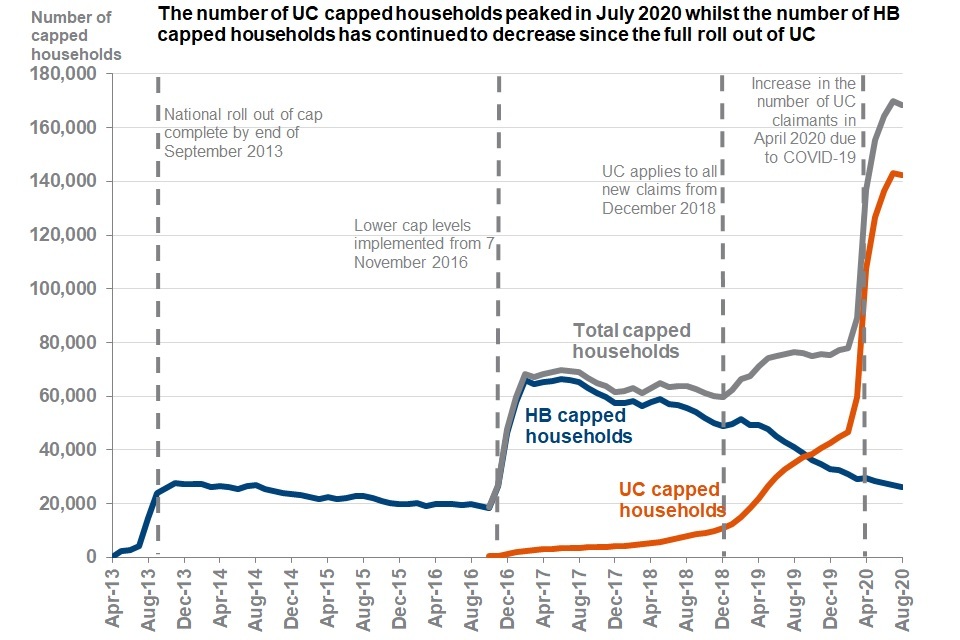
UC came into the scope of the benefit cap in October 2016 and capped households claiming UC steadily increased from 350 households (October 2016) to 11,000 households when UC was fully rolled out in December 2018. Up until this point the overall capped caseload was driven by HB capped households which reached 66,000 households in February 2017 following the change to current cap levels. The caseload remained stable until August 2017 (65,000 households) when it started to slowly decrease. Following the GB wide roll out of UC in December 2018 the households capped on UC increased as HB claimants moved onto UC. The number of UC capped caseload overtook the HB capped caseload in October 2019 with 36,000 HB households capped and 39,000 UC households capped.
Most recently the COVID-19 pandemic has seen an increase of households claiming UC and therefore an increase in UC capped households. 110,000 households claiming UC were capped in April 2020. These figures increased to a peak of 140,000 UC claiming households being capped in July 2020. Meanwhile capped HB claiming households continued to steadily decrease over this time.
See data table 3, data table 11 or Stat-Xplore for full data.
59,000 households were newly capped in the last quarter.
59,000 households had their benefits capped for the first time this quarter (May 2020 to July 2020). This is 4,500 households fewer than last quarter (February 2020 to April 2020), when 63,000 households had their benefits capped for the first time.
Newly capped figures for HB were:
- 250 households at May 2020
- 200 households at June 2020
- 180 households at July 2020
- 280 households at August 2020
Newly capped figures for UC were:
- 29,000 households at May 2020
- 16,000 households at June 2020
- 13,000 households at July 2020
It is not possible to give figures for those newly capped on UC at August as this requires HB off-flows data as per the definition of newly capped. Off-flows data for August – October will be calculated with November data.
Note: Newly capped households are those that have their benefits capped for the very first time. For UC, this excludes off-flows from HB cap who then on-flow to the UC cap.
The number of households having their UC capped for the first time peaked in April 2020, due to an increase in those claiming UC and the impact of changes to UC standard allowance in light of the COVID-19 pandemic. Some of these may have previously been capped under HB, but in this release these are not separately identified.
Due to a change in the methodology, historical outcomes data (including moving from HB to UC and still being capped) are not currently available. For this reason, it is not possible to chart a time series including for newly capped households at this time.
440,000 households have been capped at some point between April 2013 and August 2020.
220,000 households have had their UC capped at some point between October 2016 and August 2020. 220,000 households have had their HB capped at some point between April 2013 and August 2020.

Sharp rises in the number of households that have ever had their benefits capped can be observed over time as a result of:
- the national roll out of the cap in September 2013
- the introduction of the current lower cap levels in November 2016
- the national roll out of UC in December 2018
- the COVID-19 pandemic in March 2020
The increases can be explained by the number of newly capped households joining the cap following these events. The COVID-19 pandemic has seen the total number of households that have ever had their benefits capped rise by 36% from 320,000 at March 2020 to 440,000 at August 2020.
5. Characteristics of capped households
2.2% of benefit claiming households had their benefits capped at August 2020.
2.2% of households claiming HB or UC had their benefits capped at August 2020; this is an increase from 2.1% at May 2020.

3.1% of households claiming UC had their benefits capped at August 2020. The London region had the highest proportion of UC households affected by the benefit cap, with 6.1% at August 2020.
Of the 10 Local Authorities (LAs) with the highest proportion of UC households having their benefits capped, 8 of them are in the London region, at August 2020.
Scotland was the region with the lowest proportion of UC households capped at 1.3%.
See data table 18, and Households on Universal Credit through Stat-Xplore for full data on the proportion of UC capped households.

0.9% of households claiming HB had their benefits capped at August 2020. The London region had the highest proportion of HB households affected by the benefit cap, 1.2% at August 2020.
At August 2020, Scotland was the region with the lowest proportion of HB households capped at 0.4%.
See data table 18, and Housing Benefit data from April 2018 through Stat-Xplore for full data on the proportion of UC capped households.
Note: HB and UC statistics are provided on the same geographies with both being reported on residential LAs. Administrative data for HB is available in the ODS tables (1, 2, 3 and 7) and Stat Xplore. Read the Background Information and Methodology document for more information. The benefit cap can only be applied to households with at least one working age claimant. HB can be claimed by households with single pension age claimants therefore caution should be taken when interpreting these statistics.
LAs which are shaded grey in the above maps could be due to several factors such as data being sparse or missing.
6 in 10 households that have their benefits capped are single-parent families.
Since the start of the COVID-19 pandemic the proportional composition of household type has changed. There is now a:
- lower proportion of capped households with children; 93% (72,000 households) at February 2020 compared with 85% (140,000 households) at August 2020
- higher proportion of capped households with single people; 7% (5,700 households) at February 2020 and 15% (26,000 households) at August 2020.
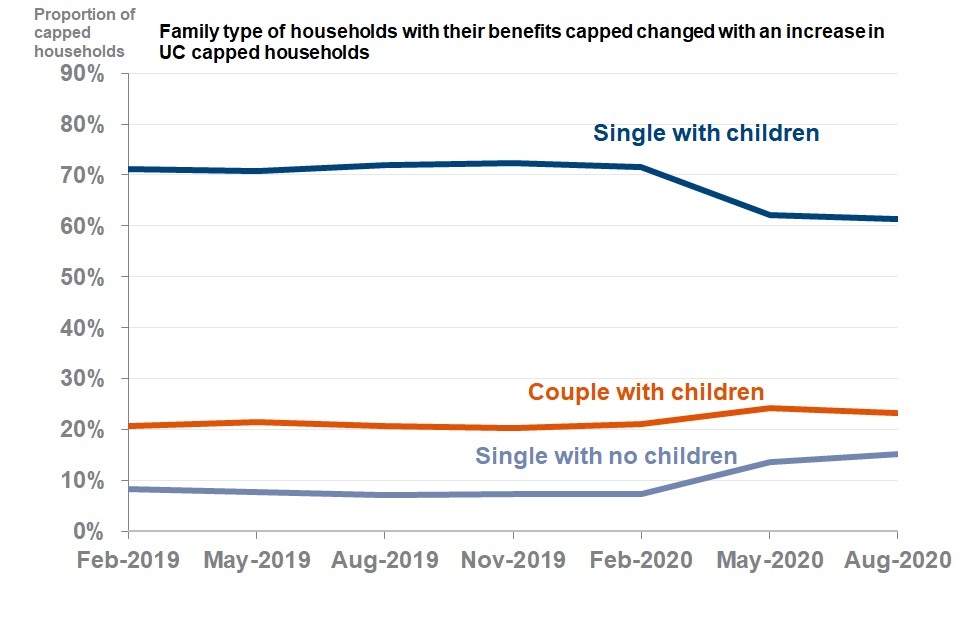
61% (100,000) of households that had their benefits capped at August 2020 were single-parent families; this is similar to the previous quarter (62% at May 2020). Prior to May 2020 the proportion of single-parent families with their benefits capped varied between 71% and 72%.
Single-person households with no children remained a similar proportion of the capped caseload between February 2019 (8% or 5,500 households) to February 2020 (7% or 5,700 households). This proportion has risen in the most recent quarters from 14% (21,000 households) at May 2020 to 15% (26,000 households) at August 2020.

49% (51,000) of single-parent capped households have at least one child aged under 5 years, including 18% (19,000) with a child aged under 2 years, at August 2020.
85% of currently capped households include children.
At August 2020, 85% (140,000) of households that had their benefits capped include children, with the figure at:
- 83% (120,000) for UC
- 93% (24,000) for HB
Of those capped households including children:
- 87% (120,000) had between 1 and 4 children
- 6% (8,000) had 5 or more children
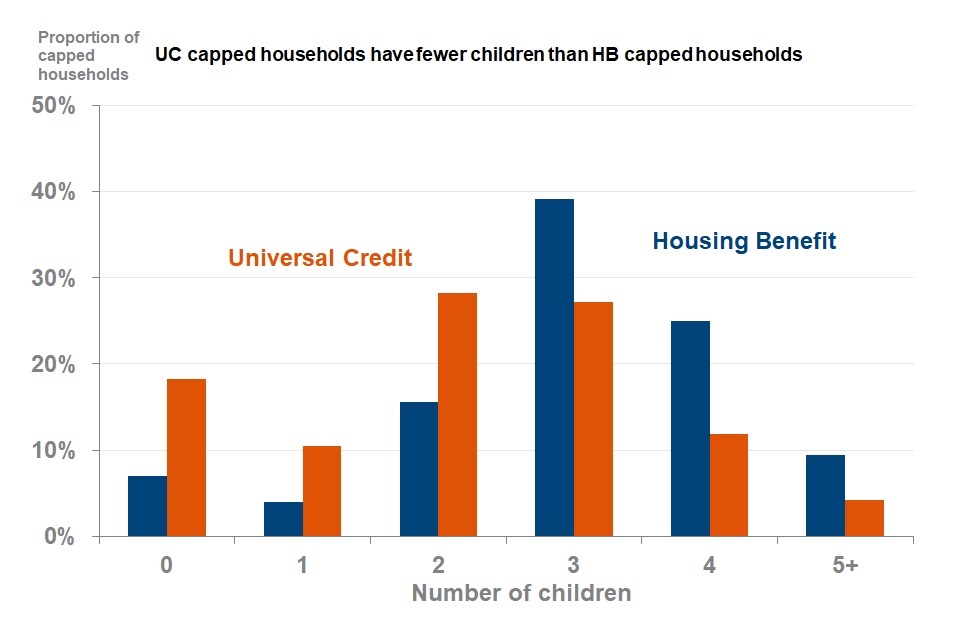
From February 2020 (data at November 2019) a new methodology to determine the number of children was developed. Figures prior to this cannot be compared.
Child Benefit and Child Tax Credits are both in scope for the HB cap, so households in receipt of these benefits are more likely to exceed the cap limit and be capped.
See data table 2, data table 9 data table 17 or Stat-Xplore for full data on the family make-up of capped households.
See data table 5 or data table 15 for full data on the age of youngest child by family type at August 2020.
See data table 8 for full data on the cumulative HB cap caseload by family type and age of youngest child.
HB Capped households by benefit make-up
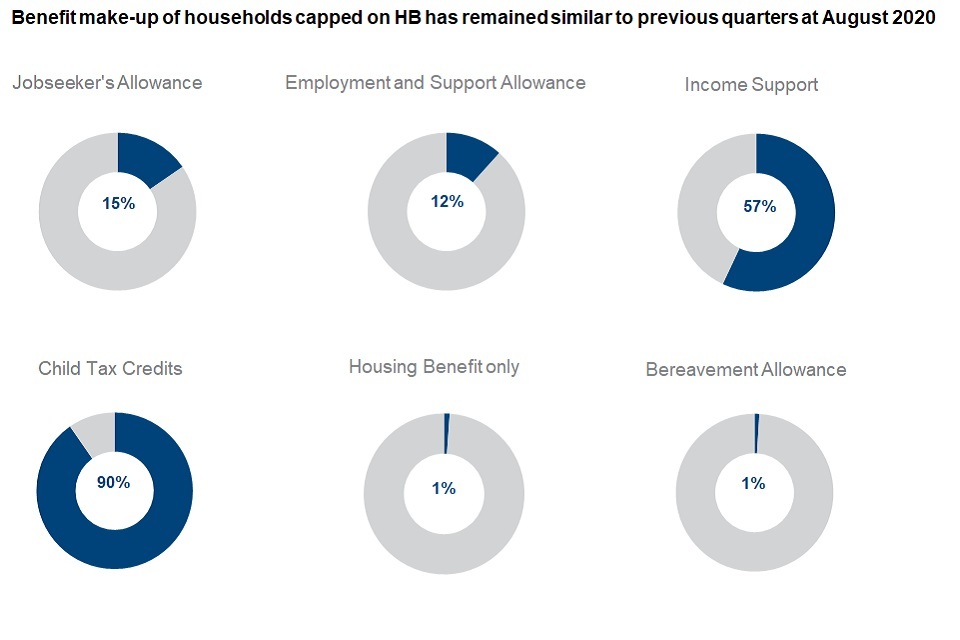
Of HB capped households at August 2020:
- 15% (4,000) were claiming Jobseeker’s Allowance
- 12% (3,000) were claiming Employment and Support Allowance (Assessment Stage and Work-Related Activity Group only)
- 57% (15,000) were claiming Income Support
- 90% (24,000) were claiming Child Tax Credits
- 1% (290) were claiming Housing Benefit only
- 1% (250) were claiming Bereavement Allowance
See data table 6 for full data.
Capped households can be in receipt of multiple benefits and therefore percentages for households in receipt of each benefit do not sum to 100%. More information on benefits that are in-scope for the benefit cap and those that are exempt can be found in the Background Information and Methodology document. Analysis is based on benefit claims by the lead claimant in a household and, where applicable, their partner. Equivalent information is not available for UC, at this time. DWP has plans to develop the methodology to provide the benefit make-up of UC capped households.
6. Households currently capped due to current lower, tiered cap levels
78% of capped households had their benefits capped due to the introduction of lower cap levels.
The benefit cap was introduced from April 2013. Changes to the benefit cap were announced in the Summer Budget 2015 and the current lower, tiered levels were introduced from 7 November 2016.
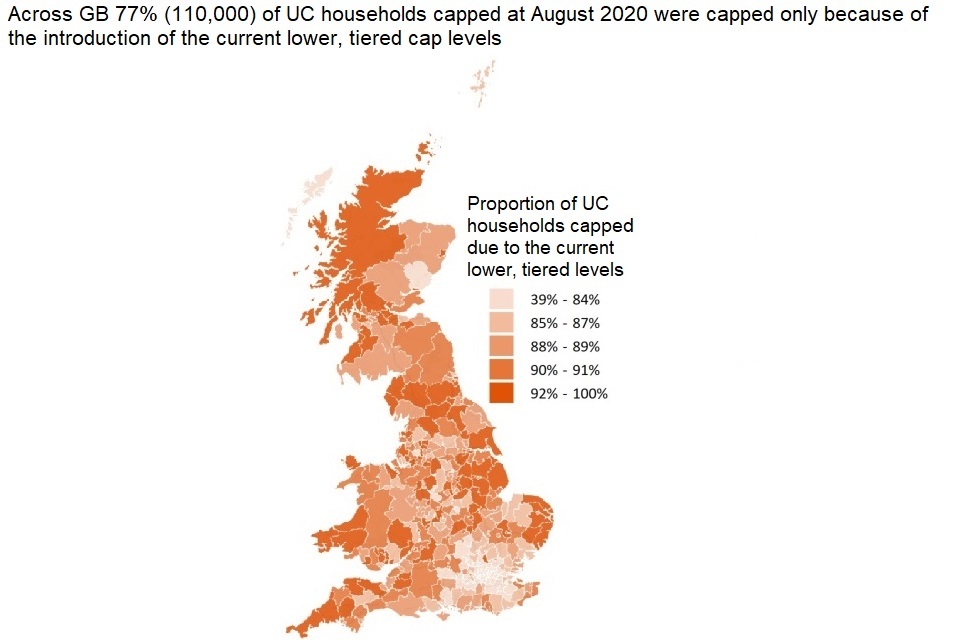
Across GB 77% (110,000) of UC households capped at August 2020 were capped only because of the introduction of the current lower, tiered cap levels.
56% of UC capped households in London are capped due to the current lower, tiered cap levels. This is a much lower proportion than the next region, which is 86% of UC capped households in the South East region.
See data table 14 for full data on the number of UC households capped because of the lower cap levels.

Across GB 80% (21,000) of HB households capped at August 2020 were capped only because of the introduction of the current lower, tiered cap levels.
See data table 7 for full data on the number of HB households capped because of the lower cap levels.
Note: HB and UC statistics are based on different geographies. It is important to note the distinction between residence-based (for UC) and administrative-based (for HB) geographies as they are not always directly comparable. See the Background Information and Methodology document for more information.
LAs which are shaded grey in the above maps could be due to several factors such as data being sparse or missing.
7. The financial impact of being capped
Households had their benefits capped by an average of £57 a week, at August 2020.
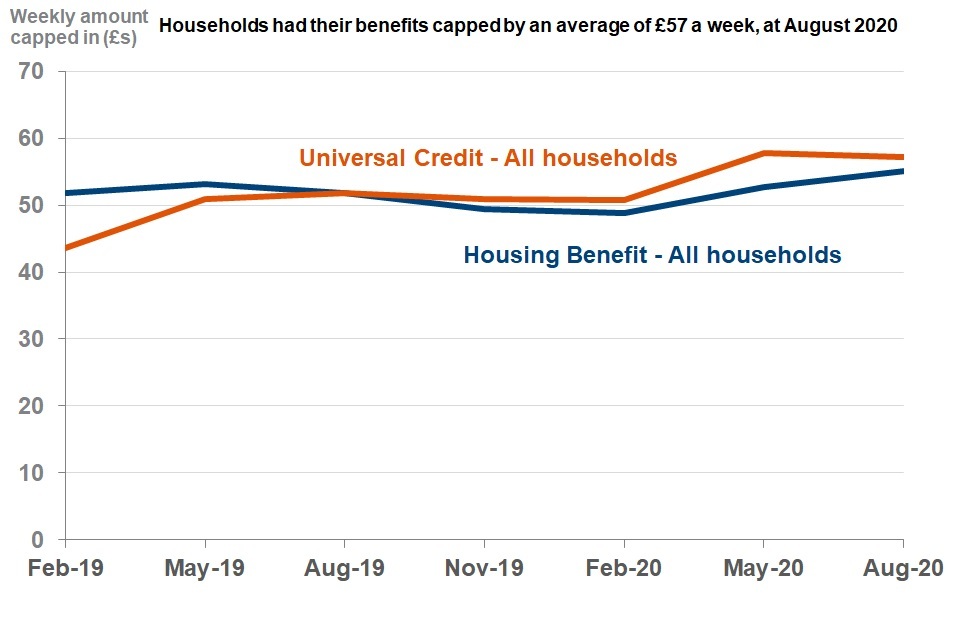
The average monthly amount that UC households are capped by is £248, at August 2020. This is the equivalent of £57 per week, a decrease from £58 at May 2020. The average weekly amount that HB households are capped by is £55, at August 2020, an increase from £53 at May 2020.
Since the start of the COVID-19 pandemic, average cap amount has increased by £6 for both benefit types:
- UC from £51 at February 2020 to £57 at August 2020
- HB from £49 at February 2020 to £55 at August 2020
UC is assessed and paid monthly and the benefit cap is applied to the full UC award. For these statistics, a weekly cap equivalent has been calculated for UC households by dividing the amount a household has been capped by for the assessment period (which lasts one month) by 4.33.
The average weekly amount of benefits capped refers to the mean amount.
See the Background Information and Methodology document for further details.
The difference in average cap amounts across the two benefits may be affected by the differences in their caseload compositions. The UC cap caseload contains a larger proportion of single people and smaller families, affecting the average amount that households are capped.
The benefit cap is applied to the full UC award not just to housing costs. Therefore, direct comparisons of cap amounts across HB and UC should be made with care.
See Stat-Xplore for full data, including by region and LA.
58% of households had their UC capped by £50 or less a week.
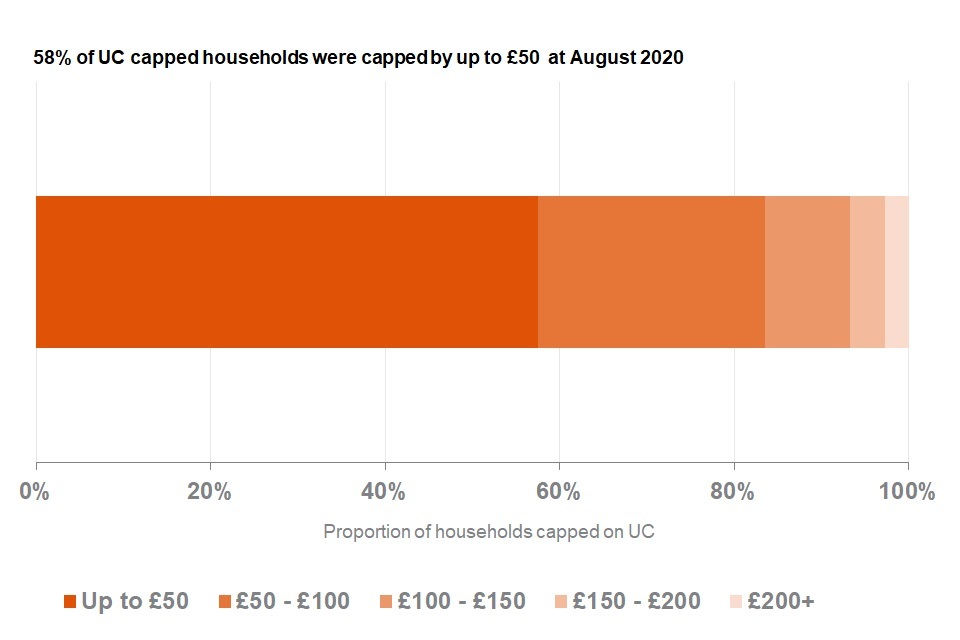
At August 2020:
- 58% (82,000) of households that had their UC capped were capped by the equivalent of £50 or less a week
- a further 26% (37,000) were capped by the equivalent of £50 to £100 per week
- 2.7% (3,800) were capped by the equivalent of £200 or more a week including 0.5% (660) capped by the equivalent of more than £300 a week.
See data table 9 or Stat-Xplore for full data.
57% of households had their HB capped by £50 or less a week.
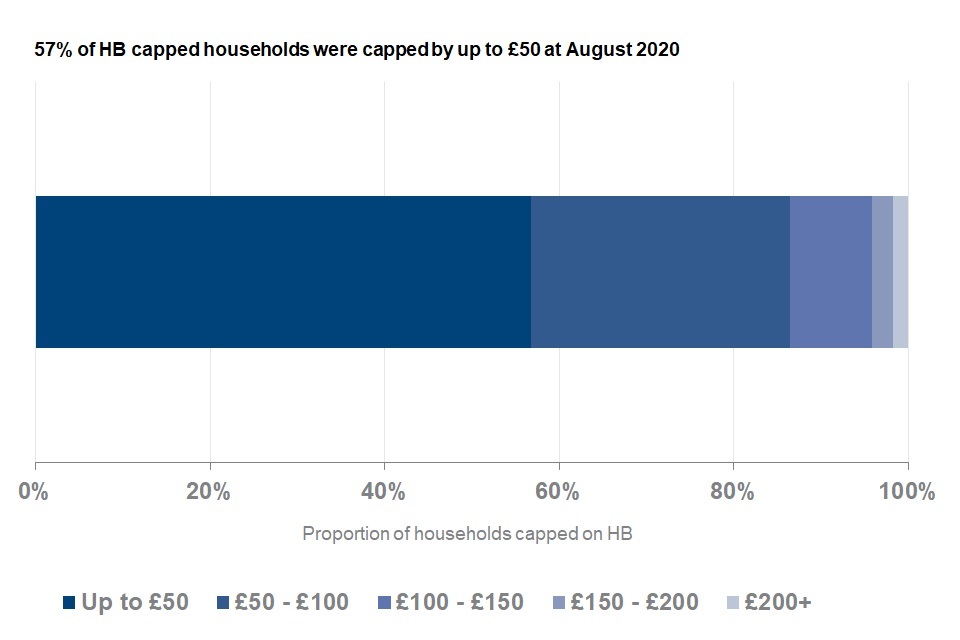
At August 2020:
- 57% (15,000) of households that had their HB capped were capped by £50 or less a week
- a further 30% (7,700) were capped by £50 to £100 per week
- 1.8% (460) were capped by £200 or more a week including 0.4% (110) capped by more than £300 a week
From 7 November 2016 cap levels were lowered, and different cap levels for households inside and outside Greater London were introduced, replacing the single cap level that existed previously.
See data table 2 or Stat-Xplore for full data.
8. Moving off the cap
79,000 (36%) households that once had their UC capped were no longer capped at August 2020.
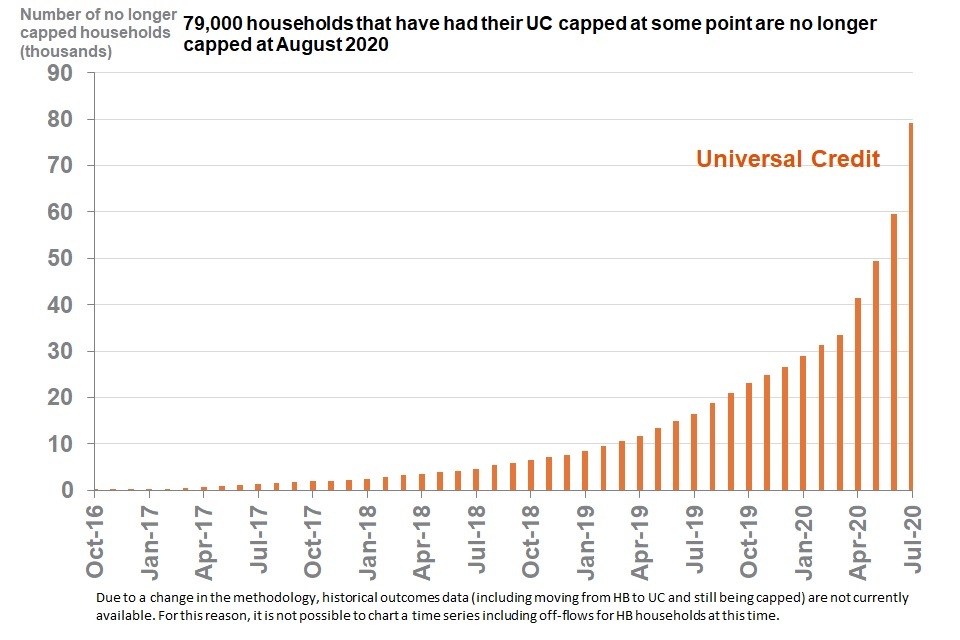
79,000 (36%) households that once had their UC capped were no longer capped at August 2020, an increase of 38,000 since last quarter (May 2020).
Of the 38,000 UC households no longer capped nearly half (47% or 18,000 households) were newly capped during this quarter.
Due to a change in the methodology, historical outcomes data (including moving from HB to UC and still being capped) are not currently available. For this reason, it is not possible to chart a time series including off-flows for HB households at this time.
See data table 4, data table 16 or Stat-Xplore for full data. `
Off-flow statistics for capped households are not directly comparable with previous statistics, due to developments in the production of the statistics. From 1 August 2019, households whose outcome for leaving the HB cap had been to move to UC are now divided into those that have moved to UC and are capped, and those that are no longer capped under UC. Due to this, total off-flow figures do not include households that move from being capped under HB to being capped under UC, although these would count as households leaving the HB cap. In order to be counted as an off-flow from the cap a household must no longer be capped on either benefit. Benefit cap off-flow outcome statistics for UC and HB are not directly comparable as the UC and HB policies are different. Further UC off-flow statistics are still in development.
20% of all households that previously had their UC capped moved off the cap because of earnings.
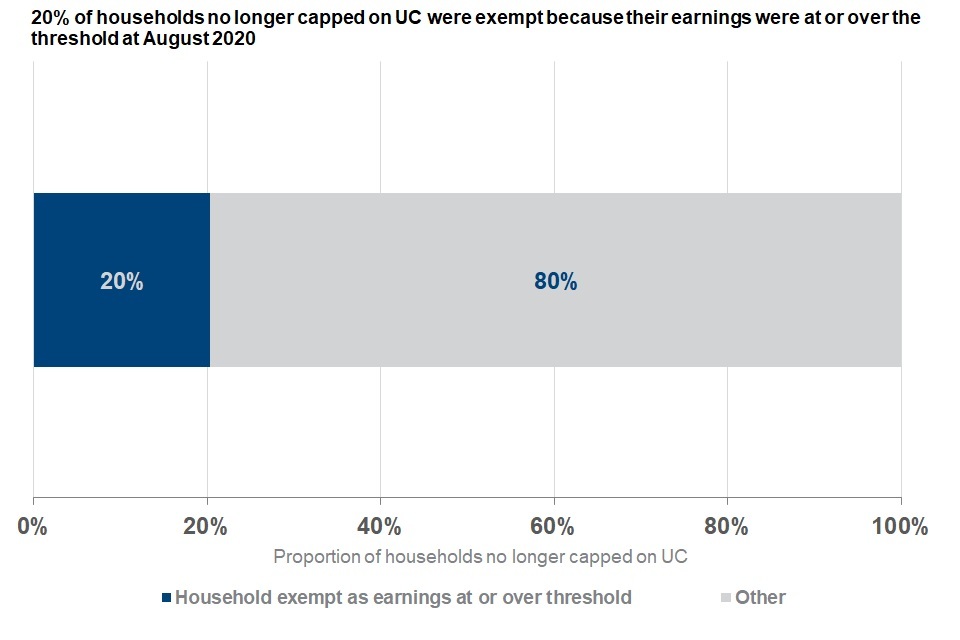
Of the 79,000 households that no longer had their UC capped at August 2020, 20% (16,000) became exempt as they were earning at least the level of the threshold at which households become exempt from the benefit cap.
The UC off-flows for this quarter align with the cumulative figure; 20% of households (7,400) that flowed off the cap in the most recent quarter left the cap due to having earnings at, or over, the earnings threshold of £604 per assessment period. This is an increase from 18% (1,100 households) at February 2020.
The earnings exemption threshold is subject to change each financial year. At the financial year 2020/21 the earnings exemption threshold is set at £604 per assessment period. The earnings exemption threshold will be updated in April 2021 for the financial year 2021/22. Details of previous exemption threshold levels can be found in Background Information and Methodology document.
See data table 16 for full data broken down by Region.
Outcome statistics for households no longer capped under UC are still under development and are not comparable with statistics for outcomes of those who are no longer capped under HB. Outcomes figures related to moving in to work have been presented separately for UC and HB. This is because under UC a household is exempt from the cap when earnings in each assessment period are at least the level of the earnings exemption threshold (for 2020 to 2021 this is £604). Under HB a household becomes exempt from the cap if it claims WTC, which depends on hours of paid work (at least 30 hours for those aged 25 to 59, at least 16 hours for single people with 1 or more children and at least 24 hours between a couple with 1 or more children).
Off-flow outcomes are shown as at the end of the quarter in which a household moved off the benefit cap, meaning the outcomes are fixed at that point, unless a household is re-capped at a later date. More detail on the way off-flow outcomes are determined is included in the Background Information and Methodology document.
8% of households that flowed off the HB cap between May 2020 and July 2020 flowed off the HB cap with an open WTC claim.
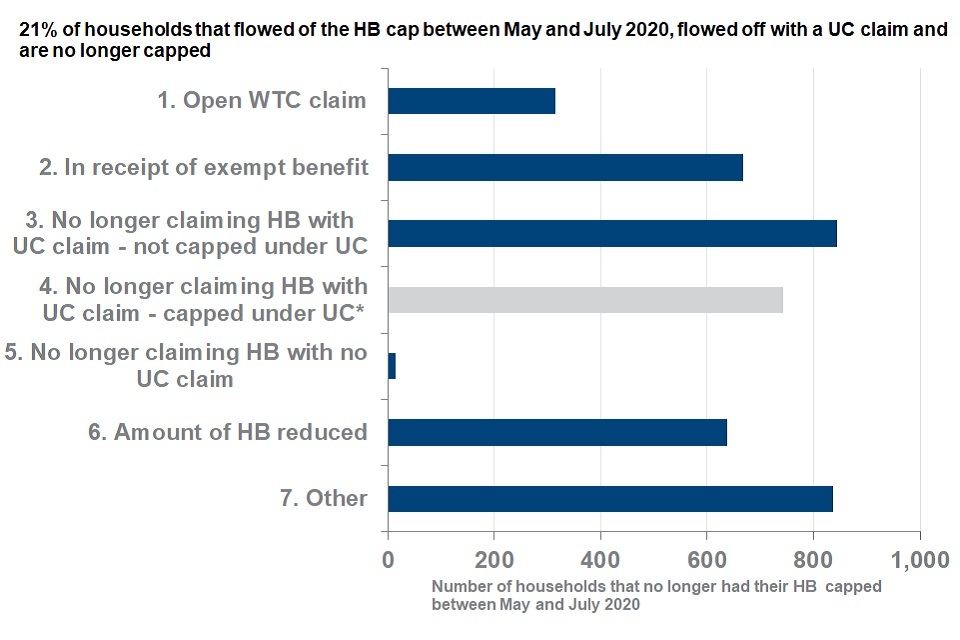
For illustration purposes and consistency with previous releases, households which have flowed from HB on to the UC cap have been included. These households are not considered in the overall off-flow figures for HB.
14% (4,100) of households that had their HB capped at May 2020, no longer had their HB capped at August 2020.
Of the 4,100 households that no longer had their HB capped between May and July 2020, 310 (8%) were exempt with an open WTC claim, indicating that they had moved into work.
1,600 (39%) households that no longer had their HB capped between May and July 2020 were no longer claiming HB when they moved off the cap but had started to claim UC.
Of those that no longer had their HB capped between May and July 2020:
- 8% (310) were exempt with an open WTC claim
- 16% (670) were in receipt of an exempt benefit
- 21% (850) were claiming UC and were not capped
- 18% (740) were claiming UC and were capped
- 16% (640) had a reduction in their HB
- 21% (840) were exempt for other reasons
See data table 4 for full data.
Households can flow off the cap for many different reasons and there may be several reasons why a household is no longer capped. These reasons are ranked (as in the chart above), only the highest ranking reason per household is counted.
See the Background Information and Methodology document for more information on how the ranking was developed and is applied, as well as detail the way off-flow outcomes are determined.
Since December 2018, WTC has been replaced by UC with only a small number of the population able to apply for WTC, see eligibility criteria here.
6% of single-parent households that came off the HB cap between May 2020 and July 2020 moved off the HB cap with an open WTC claim.
For single-parent households with a child aged under 2 years, 12% (500) came off the HB cap between May 2020 and July 2020. Of these, 8% (40) were exempt with an open WTC claim when they moved off the cap, indicating that they moved into work.
For single-parent households with a child aged under 5 years, 12% (2,000) came off the HB cap between May 2020 and July 2020. Of these, 5% (110) were exempt with an open WTC claim when they moved off the cap, indicating that they moved into work.
See data table 8 for a full data by age of youngest child.
UC has replaced tax credits since December 2018 meaning there are no new claims. However, if a claimant is getting Child Tax Credit (CTC) and they start work they can claim WTC because it’s treated as a change of circumstances which doesn’t require them to move across to UC.
Off-flow outcomes are shown as at the end of the quarter in which a household moved off the benefit cap, meaning the outcomes are fixed at that point, unless a household is re-capped at a later date. More detail on the way off-flow outcomes are determined is included in the Background Information and Methodology document.
Statistics on children in UC households are not currently available. More information can be found in the Background Information and Methodology document.
9. About these statistics
Experimental Statistics on households that had their UC capped
This release contains experimental statistics on the number of households that have had their UC capped, alongside the quarterly HB cap statistics. Since August 2019 we have published additional information on households that have their UC capped, including the number of children in these households. We are also able to identify whether households that move from HB to UC continue to be capped.
UC was introduced in 2013 and is available for all new claims across GB. UC gradually rolled out between May 2016 and December 2018. The government currently plans that by the end of 2024, all existing legacy claimants will have moved on to UC. Since UC fully rolled out, the number of households that have their UC award capped has increased and the number capped under HB has declined. In October 2019 the UC capped caseload exceeded the HB caseload for the first time.
Statistics on households capped under UC do not include figures for those capped at the start of the UC rollout. The initial, largely clerical payment system, UCLS, was gradually replaced by the current digital system, UCFS. Since March 2019 UCLS ceased to be operational and all UC awards have been delivered via the current service. Due to data quality and reporting it is not possible to produce robust experimental statistics on the number of households that were capped under UCLS. When looking at figures in a time series, it should be noted these exclude figures for UCLS in the period from April 2013 until March 2019.
Data sources
Data used to create the statistics comes from administrative databases. For these, accuracy is determined by how well the information is recorded and transmitted.
HB Data
The main source of data on households that had their HB capped is the HB Caseload Statistics. Read more about HB Caseload Statistics (including their methodology).
The HB Caseload Statistics data source is the DWP 100% Single Housing Benefit Extract (SHBE). SHBE is a monthly electronic scan of claimant level data direct from LA computer systems. SHBE includes a field that contains the weekly amount that the HB of a household has been capped by. This marker is central to the production of the statistics on households that have had their HB capped.
HB Caseload Statistics are merged with 100% DWP benefit scans, to give data on the types of benefits claimed by capped households, and with Her Majesty’s Revenue and Customs (HMRC) child benefit data, to give information on the age of the youngest child dependant in a capped household. HB caseload statistics are merged with Working Tax Credit data and 100% DWP benefit scans to provide information on the outcomes of households that have off-flowed from the benefit cap.
Data on those households who have ever had their HB capped that are no longer capped is linked to HMRC and DWP benefits data to determine why households are no longer capped.
UC Data
The main source of data on households that had their UC capped is the UC Quarterly Statistics. Read more about UC Quarterly Statistics (including their methodology).
The UC Quarterly Statistics data source is the DWP UC Official Statistics database, which is compiled using data from systems within local offices and records of UC benefit payments made by the DWP. This database includes a field that contains the amount of UC that a household has been capped by for an assessment period, which is used in the production of these statistics.
Data are merged with the DWP Customer Information System address file so that the number of households that have had their Universal Credit capped can be broken down by region and LA.
Data on households that have had their UC capped are matched with the full DWP Universal Credit Official Statistics database to obtain information on earnings, which is used to determine which households moved off the cap under UC due to becoming exempt due to their earnings.
The number of children and age of the youngest child dependant in a household is calculated by merging data held on HMRC child benefit systems to data on UC capped households. This detail is available for capped households only, and not the UC caseload.
Data coverage and reporting month
LAs extract and return their HB data to DWP over a four week rolling period based on an extraction schedule for each LA. For example, the previous “February 2020” data shown last quarter was typically extracted between 28 January and 21 February 2020. Each LA may extract its data up to a week before the date it is scheduled to be returned to DWP. Consequently, the statistics do not directly relate to a particular date but rather show the position of capped cases over a monthly cycle.
To be counted as being on UC a household must have an assessment period spanning the ‘count date’ for a particular month. An assessment period is the period of a month for which a UC payment is made. The count date is the second Thursday of the month. Entitlement to UC must also have been calculated.
Definition of a household
For the purposes of the benefit cap policy and hence this analysis, a household is defined as: “One or two adults, living together as a couple, plus any dependent children they are living with”.
This may also be termed a ‘benefit unit’. This differs from the Office for National Statistics (ONS) definition that defines a household as one person alone; or a group of people (not necessarily related) living at the same address who share cooking facilities and share a living room or sitting room or dining area. A household by the ONS definition may contain multiple benefit units.
There are a small number of cases where an individual or household has more than one HB claim, for these cases, only the most recent claim is reported on.
Changes to the benefit cap amounts from 7 November 2016
The cap amounts and the benefits that are affected by the cap changed from 7 November 2016. The Summer Budget 2015 announced changes to the level of the benefit cap to
- £20,000 a year (£13,400 for single adults with no children) nationally
- £23,000 a year (£15,410 for single adults with no children) in Greater London (the 32 London boroughs and the City of London)
The changes in cap levels were rolled-out across LAs from 7 November 2016 to 20 January 2017. From March 2017 data for all LAs reflects the lower cap levels.
Where to find out more
Use Stat-Xplore to create your own tables and further breakdowns of these statistics.
View national and regional figures in an interactive visualisation.
Read older releases of these statistics.
Read Background Information about these statistics.
Read statistics for households who have their benefits capped in Northern Ireland.
Read statistics on Housing Benefit caseload.
Read statistics on Universal Credit.
Read statistics on Local Authorities’ use of Discretionary Housing Payment funds.
Read more information on the benefit cap.
Contact us
Contact us for statistical enquiries and publication feedback only please.
Lead Statistician: Yolanda Ruiz Rodriguez
Produced by: Charlotte Stubbs
DWP Press Office: 0203 267 5144
